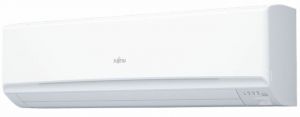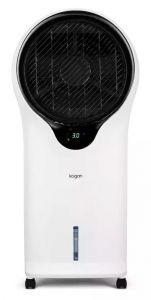No summer staple is more important in Australia than the appliance you’ll use to cool down your home. A popular option is the split system air conditioner, one of several types of air conditioners on the market. But this is often compared with the evaporative cooler, a generally much cheaper alternative to the traditional air con. But which is better? Here are some key things to keep in mind when shopping for the best cooling appliance for your home.
What is the difference between an evaporative cooler and air con?
Evaporative coolers and refrigerant air conditioners use different processes to cool down the home. While evaporative coolers evaporate water to help take the heat off, a refrigerant split system uses a refrigerant gas to cool down the home as well as two compartments that replace the hot air inside the room with cooler air from outside.
While the running costs for a refrigerant air conditioner are much more expensive, evaporative cooling is not suitable for those in high humidity areas.
How do split system air conditioners work?

A refrigerant split system contains two separate units – indoor and outdoor. These parts work together to replace the hot air inside the home with cooler air from outside, and uses refrigerant gas to further cool down the room to reach a more comfortable temperature much quicker.
A reverse cycle air conditioner is a similar alternative which still uses the same process using inside and outdoor components, except it has a condenser added to the inside unit. Refrigerant split system air conditioners and reverse cycle units are both compact, quiet and efficient to operate, but are only worth considering if you need a heating unit, as it can both cool down and warm up a room.
How do evaporative coolers work?

Evaporative coolers can also have an indoor and outdoor unit. In this case, the outdoor unit is installed on the roof to collect the air and distribute it through wet cooling pads, which are then cooled by evaporation. The cold air is then released into the home through the indoor unit.
But that’s generally where the similarities end, because the biggest difference between these two types of appliances is that evaporative cooling cools the air through evaporating water. An evaporative cooler comes with a fan and a wet cooling pad which the fan uses to gather warm air inside the appliance, before sending to the soaked water pads to be cooled.
Cooling running costs?
How much it costs to cool your home will depend on a number of factors, including the kind of appliance you use. Evaporative coolers are cheaper to run than a larger air conditioning unit but that will depend on how long you run it for, how often, the setting you have it at and the size of the room or home. Find out more about air conditioner running costs and evaporative cooling costs to see how much your energy bill may cost you.
Evaporative cooling pros and cons
Evaporative coolers offer a number of benefits but equally they do have some drawbacks that may not make them a great choice for you.
Pros:
- Work better with doors and windows open so air can flow freely, leveraging the natural breeze.
- Cheaper to buy than an air conditioning system.
- Some models are portable and easy to move from room to room.
Cons:
- Don’t work well in extremely humid climates like Queensland, Northern Territory and Western Australia.
- Can create extra humidity in a room if doors and windows are all closed.
- Needs to be serviced more regularly than an air conditioning unit.
Air conditioning pros and cons
Air conditioners are one of the more popular cooling systems but also have their own drawbacks.
Pros:
- Can cool larger spaces within a home, and are more powerful.
- Tend to last longer as an appliance once installed in a home.
- Has multiple cooling and fan settings to suit your needs.
Cons:
- More expensive upfront to purchase and incurs installation fees.
- Not ideal for open plan homes and multi-storey homes as it can be more difficult to cool.
- More expensive to run compared to other smaller appliances.
How much does an air conditioner cost?
Split system air conditioning systems cost from $700 to upwards of $3,500 depending on the model and brand. Outside of the initial cost of the unit itself, you will need to pay someone to professionally install the unit. Unfortunately it isn’t a DIY type of appliance so you will end up spending a few more hundred dollars to have it installed.
How much does an evaporative cooler cost?
Evaporative coolers are significantly cheaper to purchase upfront and tend to be cheaper to run long term. You can expect to spend from $150 for smaller more portable units up to $650 for larger units capable of cooling larger spaces. You can even find some models of outdoor evaporative coolers if you’re wanting to have an outdoor gathering but still want to beat the heat.
Deciding how you want to cool your home
How you choose to cool your home this summer will come down to personal preference, but there are a number of factors to take into consideration if choosing between an evaporative cooler and air conditioning. Price plays a large factor in the decision making process whether it’s long term savings or the upfront cost. If you’re not sold on an evaporative cooler, compare air conditioning brands below.
Air Conditioner Reviews & Ratings
Original Author: Tahnee-Jae Lopez-Vito




Share this article